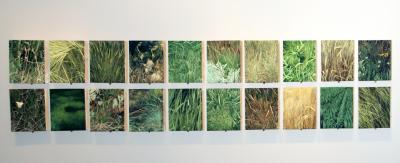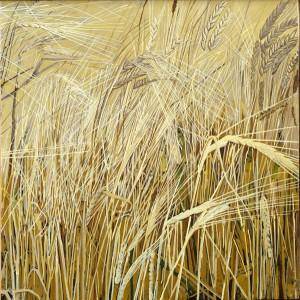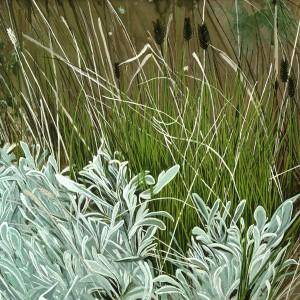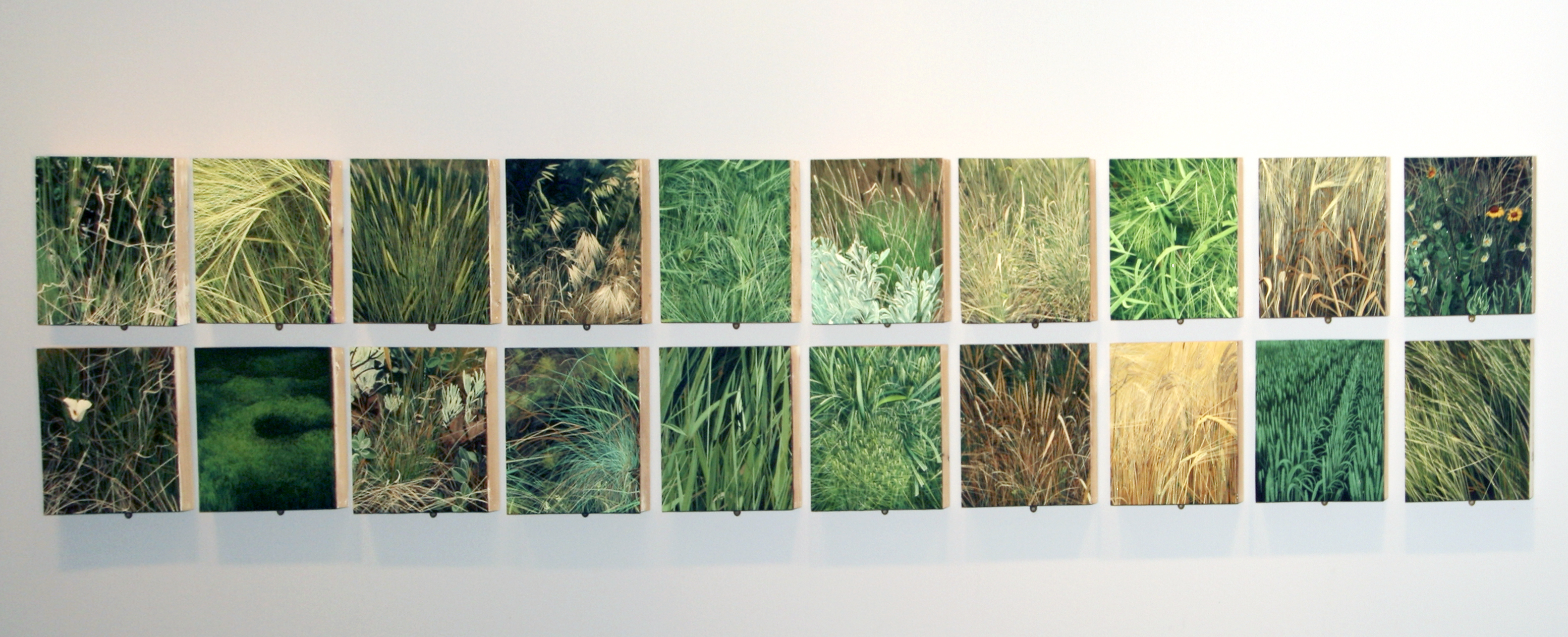Students will use American Grasslands to inspire their own investigation and representation of one square foot of natural space. The paintings will also serve to facilitate a discussion of the impact of living beings (humans and other animals) on the land. A creative writing exercise will help students consolidate what they’ve learned.
Students will be able to:
- describe what they observe with different senses;
- use information from one activity and apply it in a different setting; and
- use their imaginations and logic to enhance their creative writing.
Lesson
- Warm-up: Have students pick a small section of the classroom and sketch out what they see. Once they have the general objects, have them select an even smaller area of that section and sketch out the area including more detail. Encourage the students to portray what they see however they wish; you are not looking at their artistic skill so much as their attention to details.
- Show students the American Grasslands paintings. Using information from the About the Art section, talk about the artist’s method (one-foot squares, multiple photographs to create each piece, attention to detail). Divide a natural (i.e. non-cement or asphalt) section outside the school into square-foot areas. To do so, have the students take a 12-inch ruler outside with them and approximate a complete square area. (If you have time, you might have the students build 12 x 12 inch square frames using strips of paper glued, taped, or stapled together). Each student will take one square-foot of space and sketch out that area.
- Students will then compare their sketches to those of their classmates, looking at the different plant-life, health of the plants, etc., with each other.
- Talk about the concept of division of land. If students have ever flown in an airplane, have them share what they notice about the land when flying above it. Discuss as a class, or in small groups, how they know their home (house, apartment, etc.) is separate from another.
- Share that animals impact the land as well as humans. Have them imagine animals that might impact (or have impacted) each painting. What evidence do they see? Have each student pick one painting from Kitchel’s series and imagine an animal or bug interacting with that environment. Invite them to write about what they see and what’s going on from either the grasses’ or the living being’s perspective.
Materials
- Access to an outdoor area with some form of grasses or plants
- One ruler for every students (or one 12 x 12 inch square frame for each student)
- One sketch pad (or paper) for every student
- Assorted colored pencils
- Lined paper and pencil for each student
- About the Art section on American Grasslands
- One color copy of the paintings for every four students, or the ability to project the image onto a wall or screen
Standards
- Visual Arts
- Invent and Discover to Create
- Observe and Learn to Comprehend
- Relate and Connect to Transfer
- Envision and Critique to Reflect
- Language Arts
- Oral Expression and Listening
- Research and Reasoning
- Writing and Composition
- Reading for All Purposes
- Collaboration
- Critical Thinking & Reasoning
- Information Literacy
- Invention
- Self-Direction

American Grasslands: Prairie, Pasture, Crop, and Lawn
Karen Kitchel, United States
1997
12 in. X 12 in. (dimensions for 1 square)
Denver Art Museum Collection: Funds from Contemporary Realism Group, 1998.60
Photograph © Denver Art Museum 2009. All Rights Reserved.
Karen Kitchel was born in 1957 in Battle Creek, Michigan, and now resides in Los Angeles, California. She has lived and painted in the western United States for over twenty years. She remembers, as a child in Michigan, transplanting plants for her grandpa to earn money. “This was my experience not only with an intimate relationship to plants but also order.” In 1979, she moved to Los Angeles to attend Claremont Graduate University, where her commitment to hand-crafted painting and land-based imagery developed.
American Grasslands was Kitchel’s first series. She started painting it while living in Montana, where she found most of the grasses within two miles of her house. It took Kitchel almost four years to complete all of the 12 x 12 inch paintings. She explains that she doesn’t just fill a painting in from top to bottom, that “there are all kinds of decisions that I lost or they got away from me or they are the decisions I decided that I didn’t want to keep, so there are all sorts of paintings here that are buried.” Using oil paints and small brushes, Kitchel meticulously lays out many layers of paint with long, steady strokes. The intense focus and very small, controlled movements required for her work have given her arm pain in the past, and she now braces her elbow against a computer wrist pad to paint.
For American Grasslands, Kitchel spent a lot of time looking carefully at different types of grasses, taking photos, and collecting samples. “I use my camera as a sketchbook. I take rolls and rolls of really bad photographs… I want just a really rough image to remind me of light direction and some botanical specifics,” she says. She included many types of grasses to reference the way that people relate to the landscape today. Rather than staring at one awe-inspiring vista, we often experience the land in a more scattered way—plants in the backyard, weeds between the sidewalk cracks, what we see when we glance out a car window. “The concept of the virgin landscape is a myth that goes back to the white settlement of this country,” says Kitchel. “I wanted to show the landscape as an inhabited place, and that it wasn’t a bad thing, it was just a true condition.”
Viewers sometimes wonder at first if these images are photographs, but each square is painted by hand. Kitchel seeks a balance in her precision—she wants her plants to be identifiable and also for her “hand” to be visible in her work. She gets a “chuckle” when her work is confused for photos because she feels she’s “enhancing and creating the wildest sort of fiction with these paintings.” She says, “I do want to encourage and seduce a point of view that will get you on your hands and knees looking at something like cheatgrass. I mean, a lot of the things I’m showing in my paintings, people spend a lot of money trying to kill.”
Details

Twenty Little Paintings
The series American Grasslands: Prairie, Pasture, Crop, and Lawn consists of 112 paintings, of which the DAM owns twenty. A series of Japanese woodcuts, Hokusai’s 100 Views of Mount Fuji, gave Kitchel the idea to do 100, but she found so many good subjects that it became 112.

Squares
Kitchel chose the square shape of the paintings to signify square-foot units. Dividing the land into squares references the social and economic structure of the West, the way the land is measured and owned and the way it looks.

Scale
Close-ups are often ignored parts of western landscapes. But, while this appears at first to be a series of super close-ups, note that some squares are closer-up than others, and in some squares it’s really hard to tell distance.

Composition
Kitchel carefully composed each panel, and she works out a lot of her choices in composition on site using a camera with a lens specifically designed for close focusing. “I can walk through a field or along a path with my camera and just compose and select as I go. It helps me frame and select things and see things that you will absolutely walk past five feet above the ground.”
Funding for object education resources provided by a grant from the Morgridge Family Foundation. Additional funding provided by the William Randolph Hearst Endowment for Education Programs, and Xcel Energy Foundation. We thank our colleagues at the University of Denver Morgridge College of Education.
The images on this page are intended for classroom use only and may not be reproduced for other reasons without the permission of the Denver Art Museum. This object may not currently be on display at the museum.







